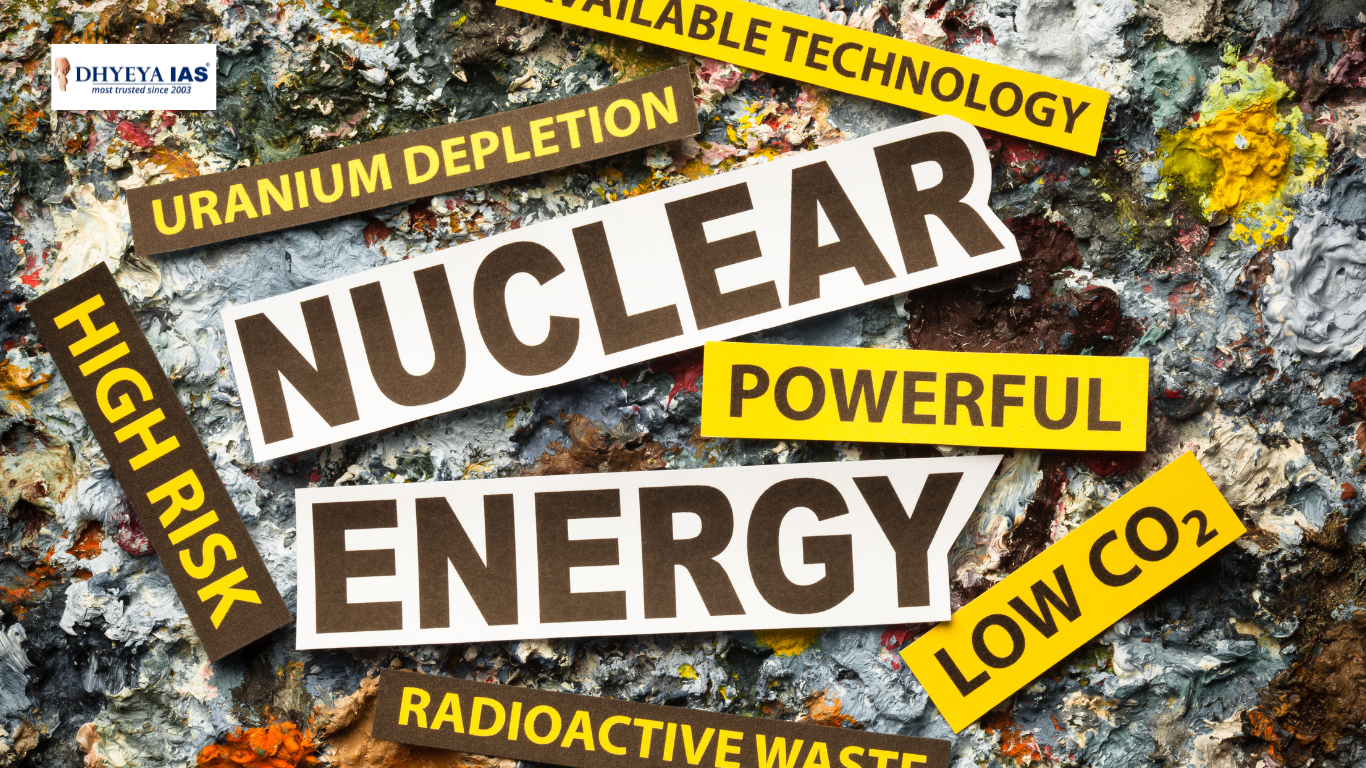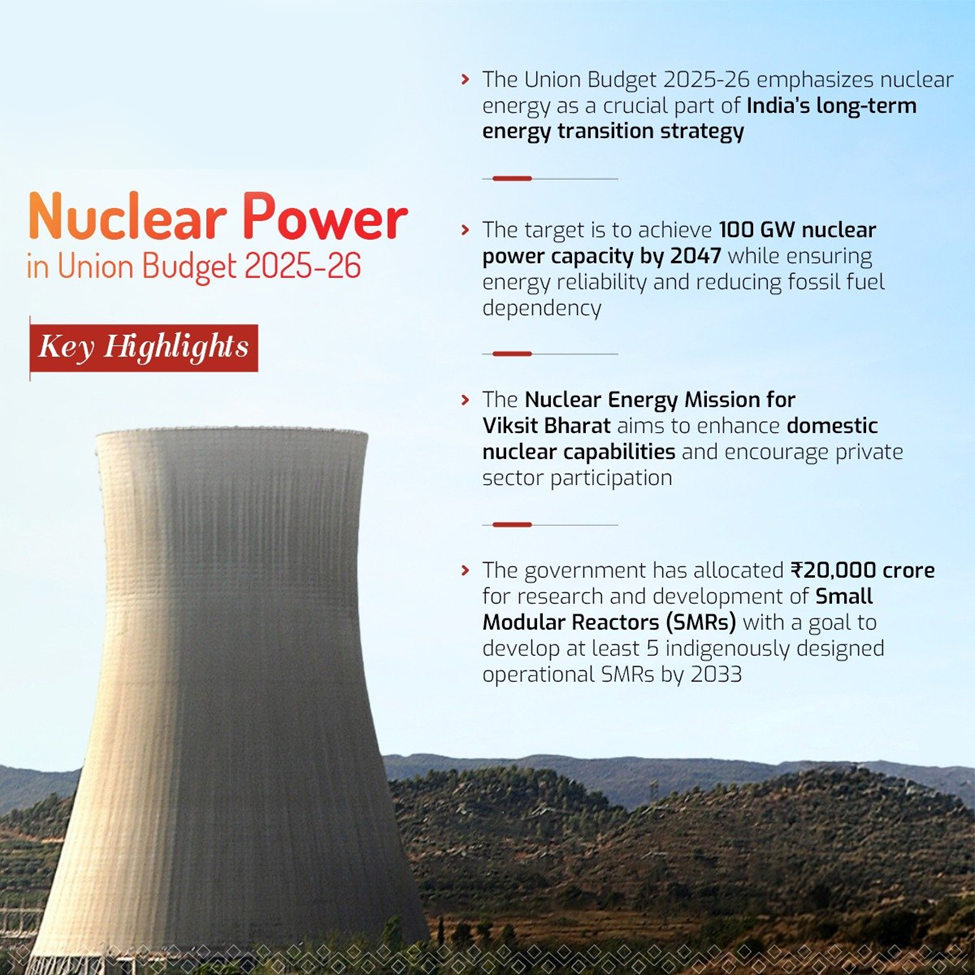The Union Budget 2025-26 has set the stage for a transformative shift in India’s energy policy, with a significant focus on nuclear energy. Recognizing the growing need for sustainable, scalable, and reliable energy, the government has outlined a comprehensive strategy to increase the country’s nuclear power capacity, positioning nuclear energy as a core component of India’s long-term energy transition. This article explores the key elements of India’s nuclear energy strategy, including the government’s ambitious goals, the role of Small Modular Reactors (SMRs), the Nuclear Energy Mission, and significant infrastructural investments.
Nuclear Energy as a Pillar of India’s Energy Transition
- Ambitious Capacity Target: The government has set an ambitious goal to achieve 100 GW of nuclear power capacity by 2047, making nuclear energy a cornerstone of India's future energy mix.
- Energy Security and Sustainability: As India seeks to reduce its dependency on fossil fuels and meet the growing energy demands of a developing nation, nuclear energy is seen as essential for ensuring energy security and sustainability.
- Alignment with Viksit Bharat: The push for nuclear power aligns with India’s broader development goals, focusing on reducing carbon emissions and advancing towards a Viksit Bharat (Developed India). The government aims to ensure energy reliability and security through indigenous nuclear technologies.
The Nuclear Energy Mission for Viksit Bharat
A critical aspect of India’s nuclear energy strategy is the Nuclear Energy Mission for Viksit Bharat. This initiative seeks to promote nuclear power as a major contributor to India’s energy security, with a focus on indigenous technologies, research, and development (R&D), and fostering private sector participation.
Nuclear R&D and Technological Innovation:
- ₹20,000 Crore Allocation: The government has allocated ₹20,000 crore to develop Small Modular Reactors (SMRs), aiming to have at least five indigenously designed SMRs operational by 2033.
- Amendments to Laws: Legislative amendments to the Atomic Energy Act and the Civil Liability for Nuclear Damage Act are planned to encourage private sector investment and reduce regulatory barriers.
- Public-Private Partnerships: The initiative emphasizes collaborations between the government and private companies, focusing on research, development, and the scaling up of nuclear energy technologies.
- Enhanced Private Sector Involvement: The government intends to involve the private sector more actively in the nuclear energy sector, from design and construction to operation and maintenance of nuclear power plants.
Small Modular Reactors (SMRs) and Their Role in India’s Energy Strategy
Small Modular Reactors (SMRs) have gained prominence as a promising technology in India’s nuclear energy expansion plan. These reactors are compact, flexible, and cost-effective, offering a range of benefits for the country’s energy needs.
- Modular Design for Flexibility: SMRs have a smaller output capacity, typically ranging from 30 MWe to 300+ MWe, which makes them scalable and adaptable to both grid and off-grid applications.
- Their modular nature allows for factory-based manufacturing, which can reduce construction timelines and lower capital costs.
- Deployment in Remote Areas: SMRs are particularly suitable for remote locations, providing a reliable and sustainable power source where other energy infrastructure may be difficult to establish.
- Their ability to be deployed in industrial areas can help meet local power demands, complementing renewable energy sources like wind and solar, which may fluctuate.
- Environmental Benefits: By integrating SMRs into the energy mix, India can significantly reduce its dependence on fossil fuels and lower carbon emissions.
- SMRs are designed to operate with minimal land requirements, addressing space constraints in densely populated regions while providing a stable, low-carbon power source.
Bharat Small Reactors (BSRs)
As part of its nuclear energy strategy, India is also focusing on the development of Bharat Small Reactors (BSRs). These reactors, based on the Pressurized Heavy Water Reactor (PHWR) design, are 220 MW in capacity and have a strong safety and operational track record.
Advantages of Bharat Small Reactors (BSRs):
- Safety and Performance: BSRs are built using the proven PHWR technology, which has been a cornerstone of India’s nuclear energy infrastructure. Their design prioritizes safety and performance, ensuring stable and secure operations.
- Integration with Industry: BSRs are designed to be deployed near heavy industries such as steel, aluminum, and metals. These industries require substantial amounts of electricity, and BSRs can serve as captive power plants, enabling them to reduce their reliance on grid power and lower emissions.
Public-Private Partnerships:
- The government is encouraging private entities to collaborate in providing land, cooling water, and capital for BSR projects. Meanwhile, the Nuclear Power Corporation of India Limited (NPCIL) will oversee reactor design, quality assurance, and operations.
- Support for Decarbonization: The deployment of BSRs supports India's decarbonization efforts by providing a reliable, low-carbon source of energy to industrial sectors, helping to meet India's climate goals.
Government Initiatives for Enhancing India’s Nuclear Capacity
- Nuclear Capacity Expansion Plan: The government aims to increase India’s nuclear capacity from 8,180 MW (as of January 2025) to 22,480 MW by 2031-32. This will involve constructing and commissioning ten reactors, totaling 8,000 MW, in multiple states including Gujarat, Rajasthan, Tamil Nadu, Haryana, Karnataka, and Madhya Pradesh.
- Pre-project activities for ten additional reactors have already started, and construction will proceed incrementally through 2031-32.
- International Collaborations: India has received in-principle approval to set up a 6 x 1208 MW nuclear power plant in partnership with the USA at Kovvada, Andhra Pradesh. This collaboration signifies India’s growing nuclear capabilities and its ability to engage in international nuclear agreements.
- Rajasthan Atomic Power Project Milestone: On September 19, 2024, Unit-7 of the Rajasthan Atomic Power Project (RAPP-7), one of India’s largest indigenous reactors, achieved criticality. This milestone marks a significant step in India’s ability to build and operate advanced nuclear reactors using homegrown technology.
Focus on Safety and Sustainability
- Radiation Safety Standards: Radiation levels at Indian nuclear facilities are consistently well below global benchmarks, demonstrating India’s commitment to safety.
- Advanced Nuclear Technologies: India is investing in advanced nuclear technologies, including high-temperature gas-cooled reactors for hydrogen co-generation and molten salt reactors, which could utilize India’s vast thorium resources.
- Commitment to Sustainability: These technologies not only enhance energy security but also contribute to India’s long-term climate goals, supporting its pledge to achieve net-zero emissions by 2070.
Recent Developments in Nuclear Energy
- Jaduguda Uranium Discovery: A significant new deposit of uranium has been discovered in the Jaduguda Mines, one of India’s oldest uranium mines. This discovery will extend the mine’s life by over fifty years, ensuring a stable supply of uranium for India’s nuclear power plants.
- Indigenous PHWRs: India’s first indigenous 700 MWe Pressurized Heavy Water Reactors (PHWRs) at Kakrapar, Gujarat (KAPS-3 & 4), began commercial operations in FY 2023-24. These reactors represent India’s growing capability in the nuclear sector.
- Prototype Fast Breeder Reactor (PFBR): India’s first PFBR, a 500 MWe reactor, achieved significant milestones in 2024, including core loading and commissioning of sodium pumps, bringing India closer to realizing its fast breeder reactor technology.
- ASHVINI Joint Venture: NPCIL and NTPC have signed a joint venture agreement, ASHVINI, to develop nuclear power plants across India. This partnership will play a crucial role in building new nuclear infrastructure.
Conclusion
The Union Budget 2025-26 signals a significant shift in India’s energy policy, emphasizing nuclear power as a sustainable, scalable, and secure energy source. With the Nuclear Energy Mission for Viksit Bharat, the government is working to build a robust nuclear energy sector, supported by indigenous technologies, policy reforms, and public-private partnerships. By focusing on advanced nuclear technologies like Small Modular Reactors and Bharat Small Reactors, and expanding its nuclear infrastructure, India is positioning itself to be a global leader in nuclear energy by 2047, contributing to both energy security and environmental sustainability.
| Main question: Evaluate the significance of public-private partnerships in India’s nuclear energy sector. How will these collaborations contribute to achieving the goal of 100 GW of nuclear capacity by 2047? |








